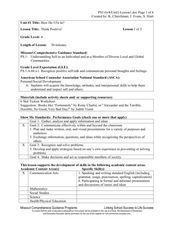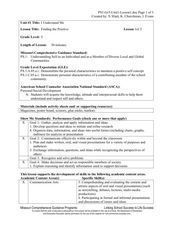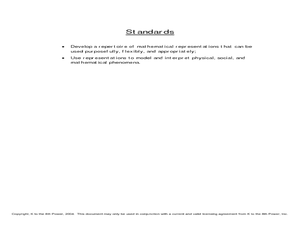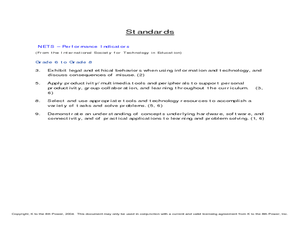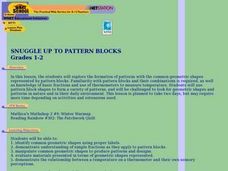Curated OER
Presidents: Past and Present
Learners identify George Washington and the current president and distinguish between past and present events. They listen to a text about Washington and make predictions. They generate a list of synonyms for past and present and...
Curated OER
Make a Dinosaur
Students estimate the size of dinosaurs and create a dinosaur model. They create bar graphs of the sizes of dinosaurs one in meters and the other in "student" units. They draw a pictures and add words or sentences about their dinosaur.
Curated OER
Pond Exploration
Pupils take a hands-on approach to explore the world beneath the water in this activity. They examine the creatures they catch to study about the adaptations these animals have that allow them to survive in this harsh environment. They...
Curated OER
Underground Railroad
Eighth graders explore the Underground Railroad. In this American History lesson, 8th graders create a song about the railroad. Students analyze various symbols used during the Underground Railroad.
Curated OER
From Seeds to Plants
Second graders review the process of plant reproduction and the role of seeds in that process. The students dissect a seed, analyze their finds, collect and record data, and make predictions about seed germination and plant growth.
Curated OER
The Gift of Community
Students explore the diversity offered in communities. In this Teaching Tolerance lesson, students read The Gift and then interview people within their school community regarding the gifts they receive in their community.
Curated OER
Think Positive!
Fourth graders are read a story in which they identify the positive and negative thinking. In groups, they are given a scenerio in which they change the negatives into a positive. They perform the scenerio to tthe class and discuss how...
Curated OER
Japanese Carp Kites/Children's Day
Students listen to the story "A Carp for Kimiko" and discuss its instructional activity and theme. They design and create their own carp kite in celebration of Children's Day. They discuss gender discrimination and how that makes them feel.
Curated OER
Japanese Carp Kites
Students listen to the story A Carp for Kimiko and discuss its theme/instructional activity. Then they identify and are introduced to the Japanese holiday, Children's Day, formerly known as Boy's Day. Students also design and create...
Curated OER
Completing Applications
Tenth graders determine the importance of exemplary job applications. In this job application lesson plan, 10th graders examine job applications that have been filled in poorly and those that are done well. They complete job applications...
Curated OER
Finding the Positive
Fifth graders meet the "Famous Artist." They are introduced to the topic of self-concept. Students work in small groups and get organized to create collages. They create a collage that represents characteristics of positive self-concept.
Curated OER
Traveling the Career Paths 1
Students explore careers. In this life goals lesson, students examine several career paths as they listen to puppets present different types of jobs and discuss the importance of each of the jobs.
Curated OER
Peer Pressure
Learners talk about how their peers can influence their behavior. In this peer pressure instructional activity, students complete a KWL chart on peer pressure, read a handout on peer pressure and break into groups to discuss the...
Curated OER
Kokeshi Dolls
Students create Kokeshi Dolls using paints, dowel ends and glue. They research the traditions and history of Hina Matsuri, or girls' day in Japan.
Curated OER
Traveling the Career Paths 2
Students discover the six different career paths they could take and why each path is important. In this career choice lesson, students discuss different career paths using a visual poster. Students then play...
Curated OER
Regular And Irregular Plurals
Sixth graders engage in a lesson that covers the use of regular and irregular plurals. They practice using four different games which work for keeping the student level of engagement high. Students review the rules of basic plurals and...
Curated OER
Count, Compare and Make Change
Second graders review the value of coins and how to make change. In this counting money activity, 2nd graders compare coins, practice making change, and review the value of coins using hands-on activities.
Curated OER
Revise and Edit Writing
Seventh graders write, revise, and edit a letter and a story. In this revising and editing lesson plan, 7th graders learn the differences between revising and editing by doing the two to a letter and eventually a story.
Curated OER
Use Information in Line, Bar, Circle, and Picture Graphs to Make Comparisons and Predictions
Eighth graders explore the concept of graphs. In this graphs lesson, 8th graders compare and contrast picture graphs, bar graphs, line graphs, and circle graphs. Students examine each type of graph and answer questions and make...
Curated OER
Snuggle Up To Pattern Blocks
Young scholars view and discuss a video about the use of pattern block shapes to form pictures. They, in groups, form garden and quilt designs using pattern blocks and then decorate the room with their art.
Curated OER
Chinese New Year: Paper Lanterns Lesson Plan
First graders examine a typical Chinese New Year celebration. As a class, they identify the traditions and values used and discuss how they are unique to China. To end the instructional activity, they take measurements to make their...
Curated OER
Short A Words
Students study the short "a" sound. In this word study lesson, students brainstorm words that begin with a short "a" sound and are given a picture of the word. Students play an online game to reinforce the concepts taught.
Curated OER
Elmer the Elephant
Learners read "Elmer" by David McKee. They answer comprehension questions and discuss how Elmer looks and how he is different from the elephants they see in the zoo. They complete a project in which they celebrate their individual...
Curated OER
Estimation Investigation
Students view an interactive video to explore the concepts of estimation. They work cooperatively to measure, make comparisons, make predictions, and verify results.






